The Influence of CEO Duality on Firm Performance: Research Proposal
VerifiedAdded on 2020/04/21
|24
|5293
|86
Report
AI Summary
This research proposal examines the impact of CEO duality, where the CEO also serves as the chairman of the board, on firm performance. It explores the arguments for and against this leadership structure, considering its implications for corporate governance. The proposal outlines the research objectives, questions, and methodology, including a literature review that covers agency theory and stewardship theory as frameworks for understanding the relationship between CEO duality and firm outcomes. The study aims to clarify how CEO duality influences various aspects of a company's success, weighing the potential benefits of a unified leadership structure against the risks of concentrated power and reduced board oversight. The research will investigate the roles and responsibilities of both the CEO and the chairman, analyzing how their combined or separate functions affect decision-making, monitoring, and overall organizational effectiveness. The anticipated conclusion will summarize the findings, contributing to the ongoing debate on optimal leadership models in corporate settings.
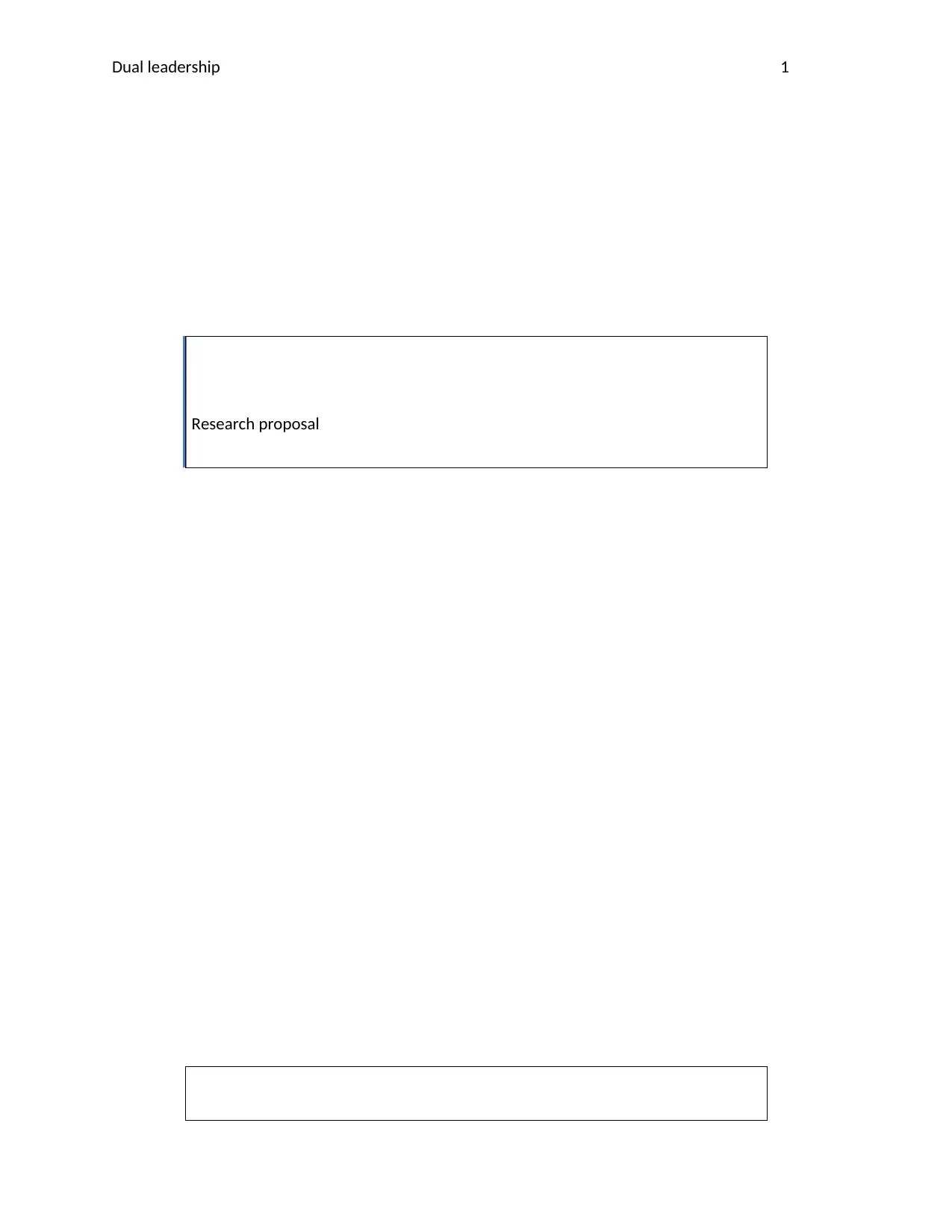
Dual leadership 1
Research proposal
Research proposal
Paraphrase This Document
Need a fresh take? Get an instant paraphrase of this document with our AI Paraphraser
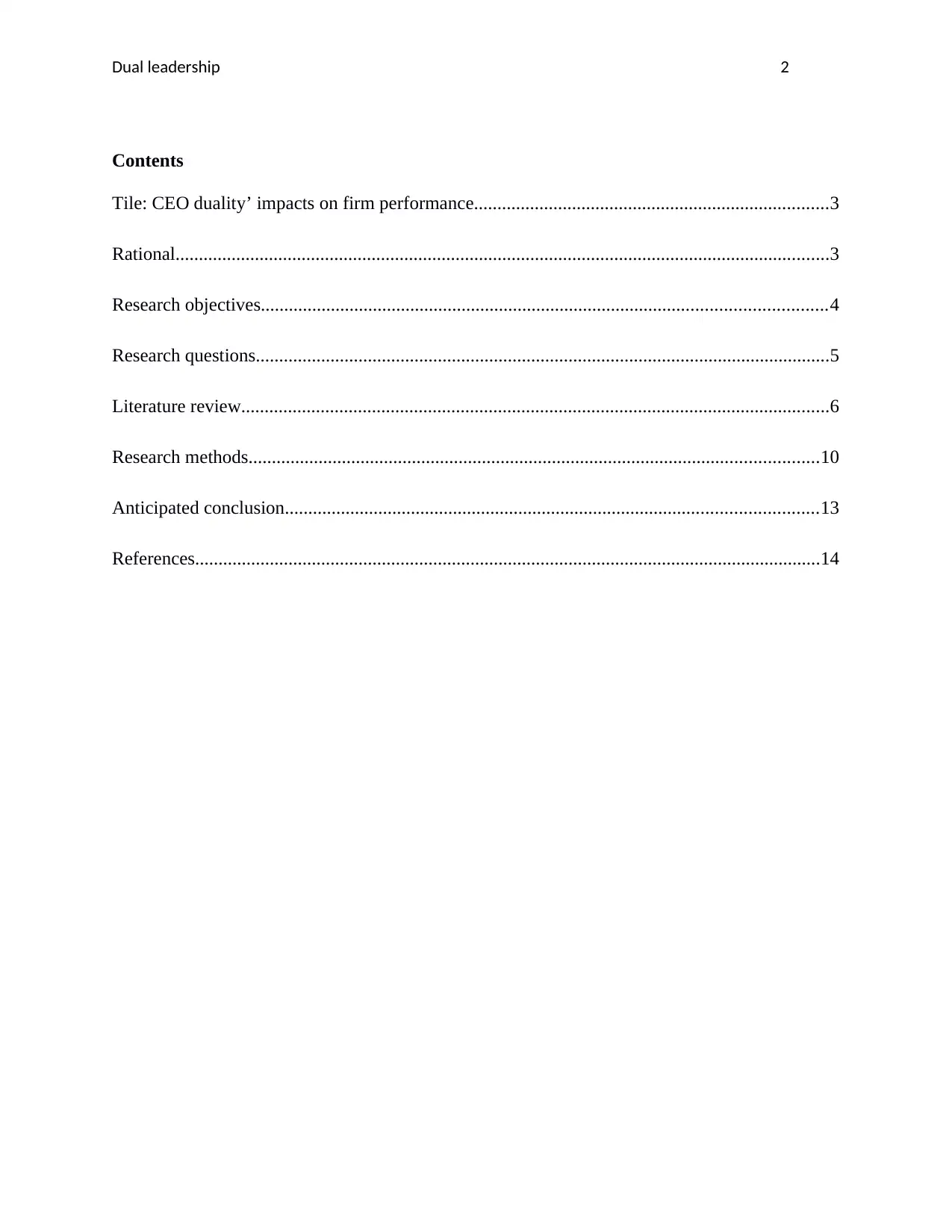
Dual leadership 2
Contents
Tile: CEO duality’ impacts on firm performance............................................................................3
Rational............................................................................................................................................3
Research objectives.........................................................................................................................4
Research questions...........................................................................................................................5
Literature review..............................................................................................................................6
Research methods..........................................................................................................................10
Anticipated conclusion..................................................................................................................13
References......................................................................................................................................14
Contents
Tile: CEO duality’ impacts on firm performance............................................................................3
Rational............................................................................................................................................3
Research objectives.........................................................................................................................4
Research questions...........................................................................................................................5
Literature review..............................................................................................................................6
Research methods..........................................................................................................................10
Anticipated conclusion..................................................................................................................13
References......................................................................................................................................14
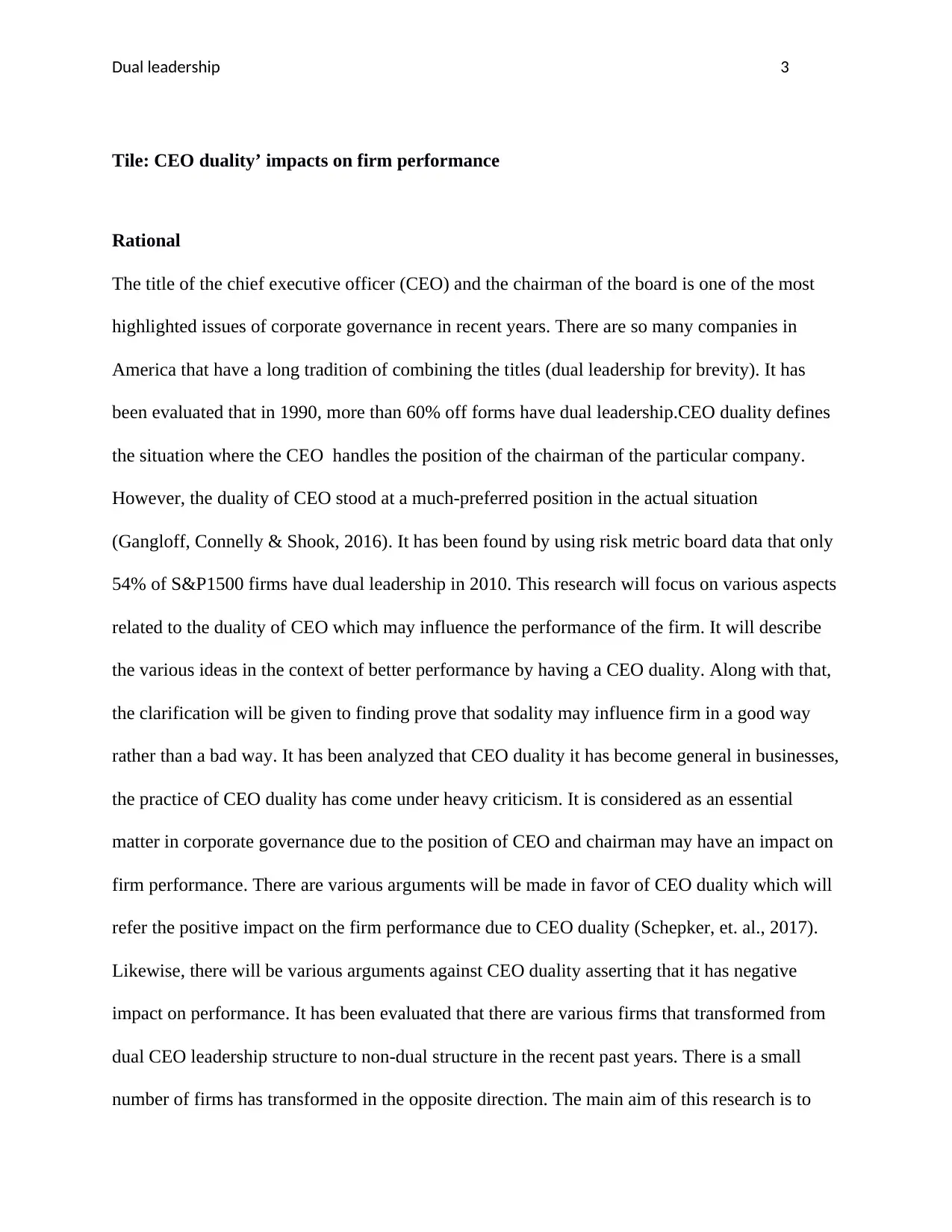
Dual leadership 3
Tile: CEO duality’ impacts on firm performance
Rational
The title of the chief executive officer (CEO) and the chairman of the board is one of the most
highlighted issues of corporate governance in recent years. There are so many companies in
America that have a long tradition of combining the titles (dual leadership for brevity). It has
been evaluated that in 1990, more than 60% off forms have dual leadership.CEO duality defines
the situation where the CEO handles the position of the chairman of the particular company.
However, the duality of CEO stood at a much-preferred position in the actual situation
(Gangloff, Connelly & Shook, 2016). It has been found by using risk metric board data that only
54% of S&P1500 firms have dual leadership in 2010. This research will focus on various aspects
related to the duality of CEO which may influence the performance of the firm. It will describe
the various ideas in the context of better performance by having a CEO duality. Along with that,
the clarification will be given to finding prove that sodality may influence firm in a good way
rather than a bad way. It has been analyzed that CEO duality it has become general in businesses,
the practice of CEO duality has come under heavy criticism. It is considered as an essential
matter in corporate governance due to the position of CEO and chairman may have an impact on
firm performance. There are various arguments will be made in favor of CEO duality which will
refer the positive impact on the firm performance due to CEO duality (Schepker, et. al., 2017).
Likewise, there will be various arguments against CEO duality asserting that it has negative
impact on performance. It has been evaluated that there are various firms that transformed from
dual CEO leadership structure to non-dual structure in the recent past years. There is a small
number of firms has transformed in the opposite direction. The main aim of this research is to
Tile: CEO duality’ impacts on firm performance
Rational
The title of the chief executive officer (CEO) and the chairman of the board is one of the most
highlighted issues of corporate governance in recent years. There are so many companies in
America that have a long tradition of combining the titles (dual leadership for brevity). It has
been evaluated that in 1990, more than 60% off forms have dual leadership.CEO duality defines
the situation where the CEO handles the position of the chairman of the particular company.
However, the duality of CEO stood at a much-preferred position in the actual situation
(Gangloff, Connelly & Shook, 2016). It has been found by using risk metric board data that only
54% of S&P1500 firms have dual leadership in 2010. This research will focus on various aspects
related to the duality of CEO which may influence the performance of the firm. It will describe
the various ideas in the context of better performance by having a CEO duality. Along with that,
the clarification will be given to finding prove that sodality may influence firm in a good way
rather than a bad way. It has been analyzed that CEO duality it has become general in businesses,
the practice of CEO duality has come under heavy criticism. It is considered as an essential
matter in corporate governance due to the position of CEO and chairman may have an impact on
firm performance. There are various arguments will be made in favor of CEO duality which will
refer the positive impact on the firm performance due to CEO duality (Schepker, et. al., 2017).
Likewise, there will be various arguments against CEO duality asserting that it has negative
impact on performance. It has been evaluated that there are various firms that transformed from
dual CEO leadership structure to non-dual structure in the recent past years. There is a small
number of firms has transformed in the opposite direction. The main aim of this research is to
⊘ This is a preview!⊘
Do you want full access?
Subscribe today to unlock all pages.

Trusted by 1+ million students worldwide
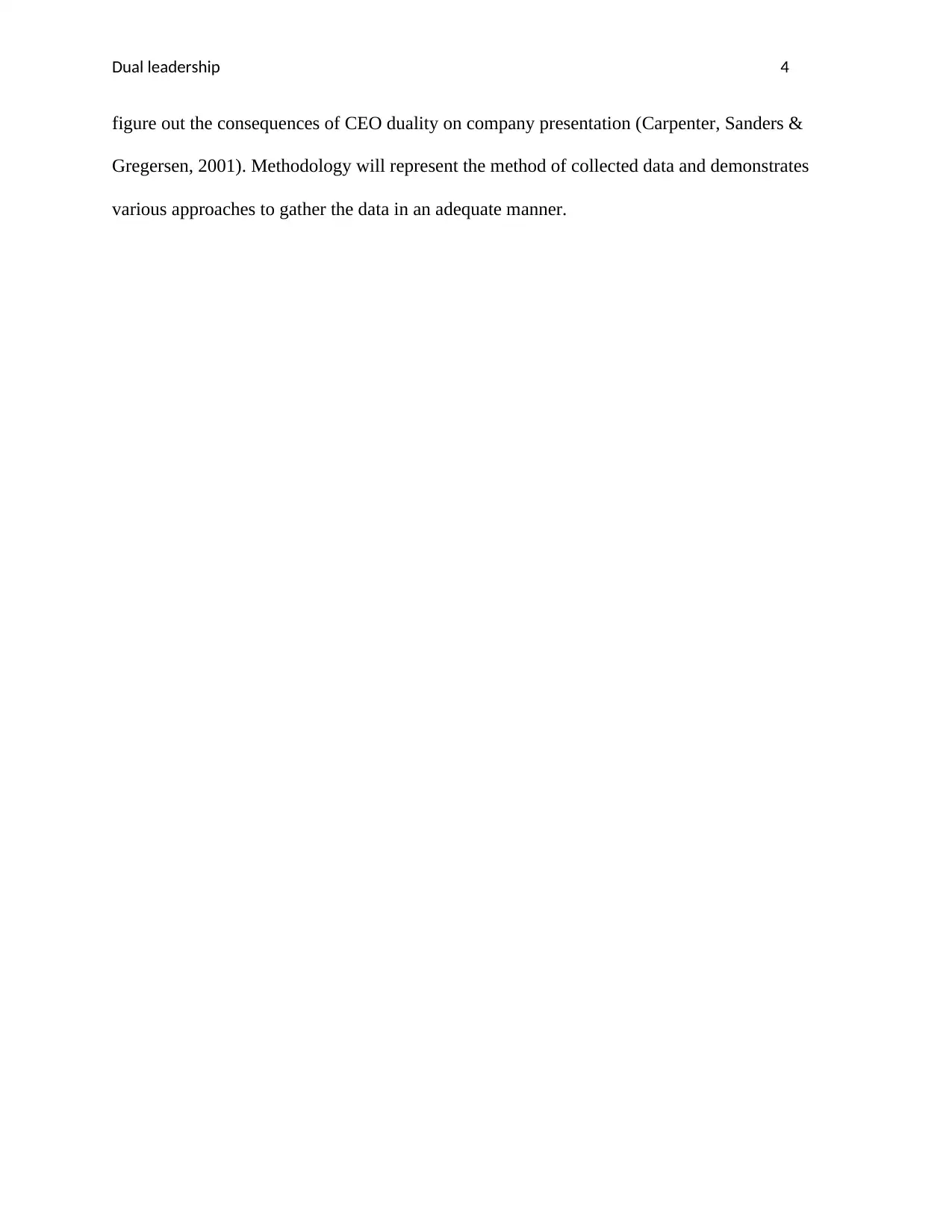
Dual leadership 4
figure out the consequences of CEO duality on company presentation (Carpenter, Sanders &
Gregersen, 2001). Methodology will represent the method of collected data and demonstrates
various approaches to gather the data in an adequate manner.
figure out the consequences of CEO duality on company presentation (Carpenter, Sanders &
Gregersen, 2001). Methodology will represent the method of collected data and demonstrates
various approaches to gather the data in an adequate manner.
Paraphrase This Document
Need a fresh take? Get an instant paraphrase of this document with our AI Paraphraser
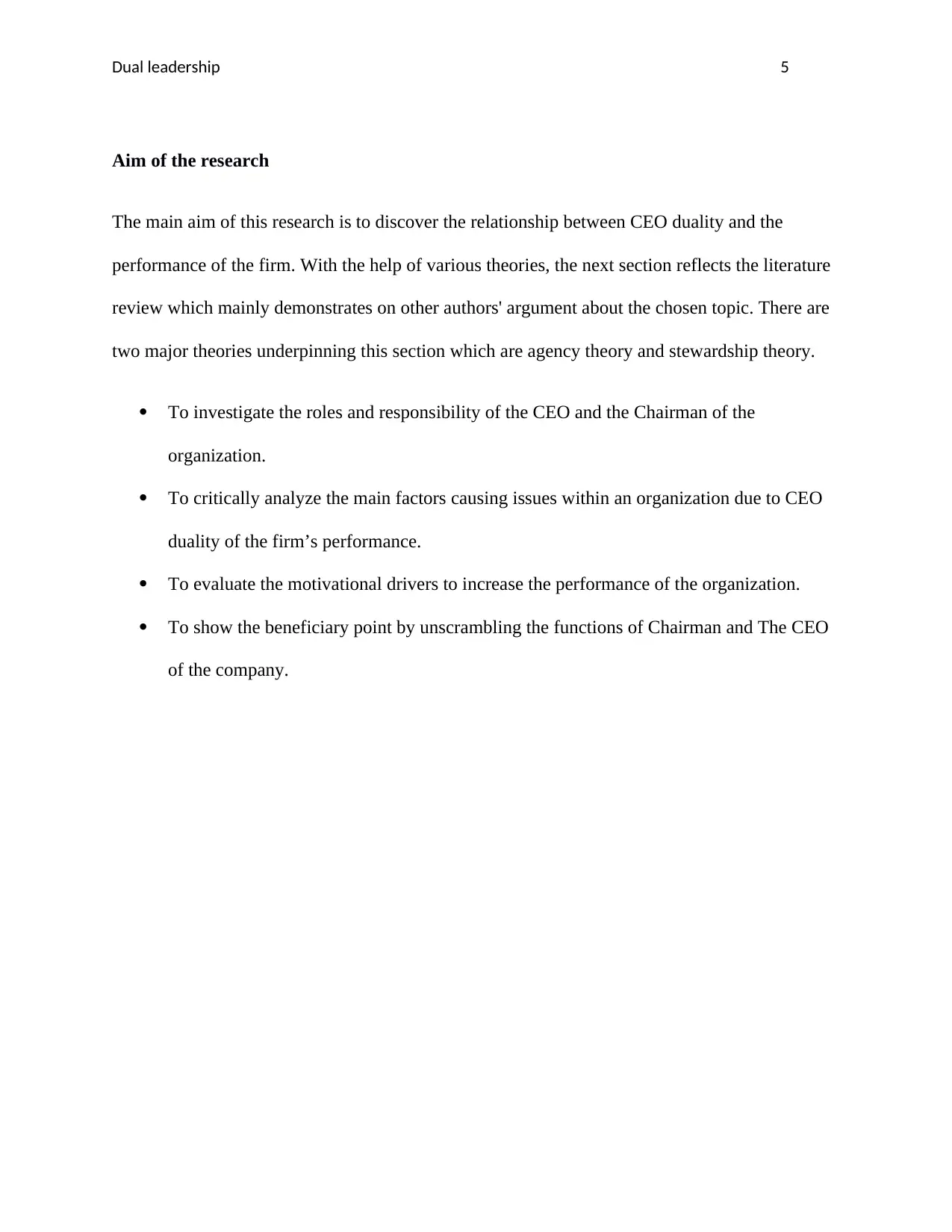
Dual leadership 5
Aim of the research
The main aim of this research is to discover the relationship between CEO duality and the
performance of the firm. With the help of various theories, the next section reflects the literature
review which mainly demonstrates on other authors' argument about the chosen topic. There are
two major theories underpinning this section which are agency theory and stewardship theory.
To investigate the roles and responsibility of the CEO and the Chairman of the
organization.
To critically analyze the main factors causing issues within an organization due to CEO
duality of the firm’s performance.
To evaluate the motivational drivers to increase the performance of the organization.
To show the beneficiary point by unscrambling the functions of Chairman and The CEO
of the company.
Aim of the research
The main aim of this research is to discover the relationship between CEO duality and the
performance of the firm. With the help of various theories, the next section reflects the literature
review which mainly demonstrates on other authors' argument about the chosen topic. There are
two major theories underpinning this section which are agency theory and stewardship theory.
To investigate the roles and responsibility of the CEO and the Chairman of the
organization.
To critically analyze the main factors causing issues within an organization due to CEO
duality of the firm’s performance.
To evaluate the motivational drivers to increase the performance of the organization.
To show the beneficiary point by unscrambling the functions of Chairman and The CEO
of the company.
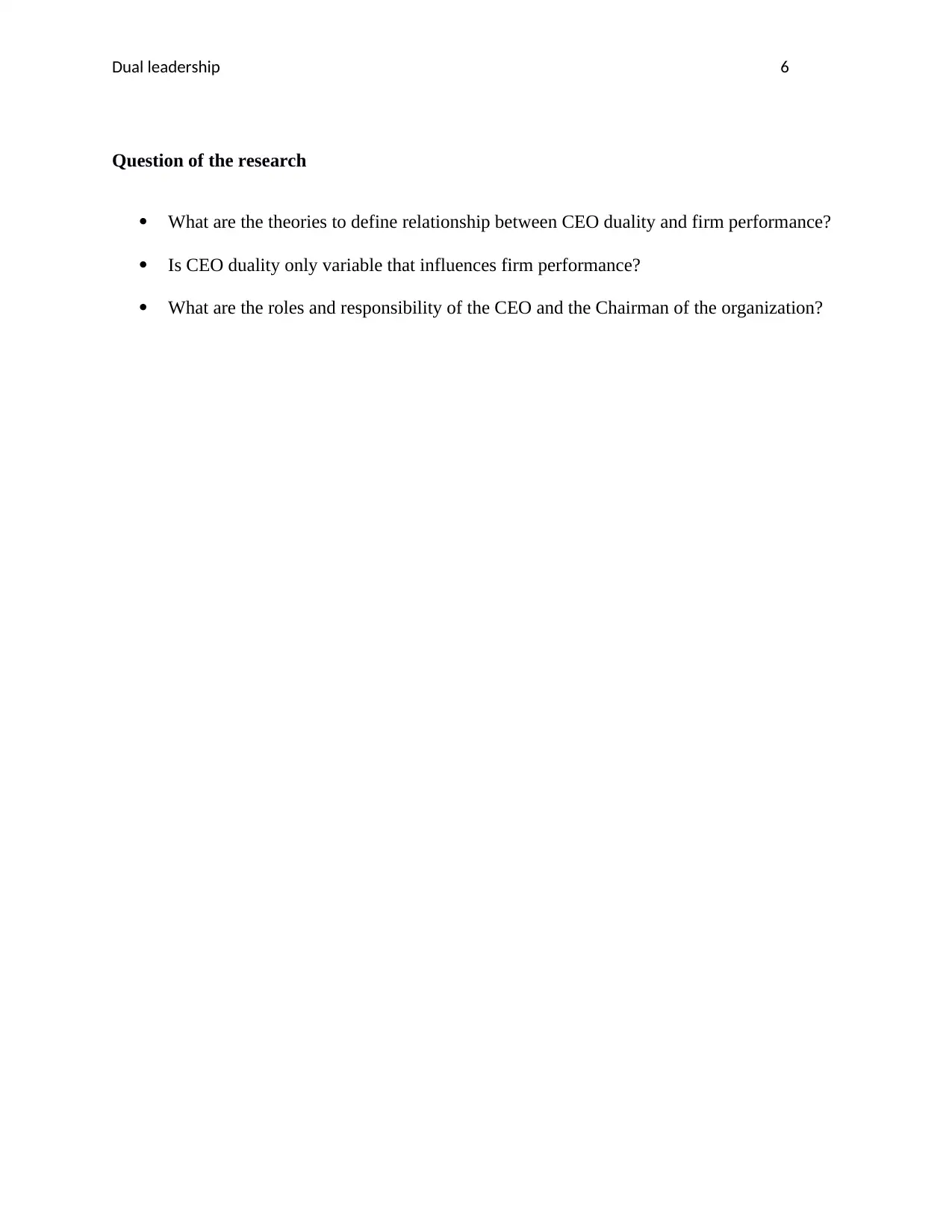
Dual leadership 6
Question of the research
What are the theories to define relationship between CEO duality and firm performance?
Is CEO duality only variable that influences firm performance?
What are the roles and responsibility of the CEO and the Chairman of the organization?
Question of the research
What are the theories to define relationship between CEO duality and firm performance?
Is CEO duality only variable that influences firm performance?
What are the roles and responsibility of the CEO and the Chairman of the organization?
⊘ This is a preview!⊘
Do you want full access?
Subscribe today to unlock all pages.

Trusted by 1+ million students worldwide
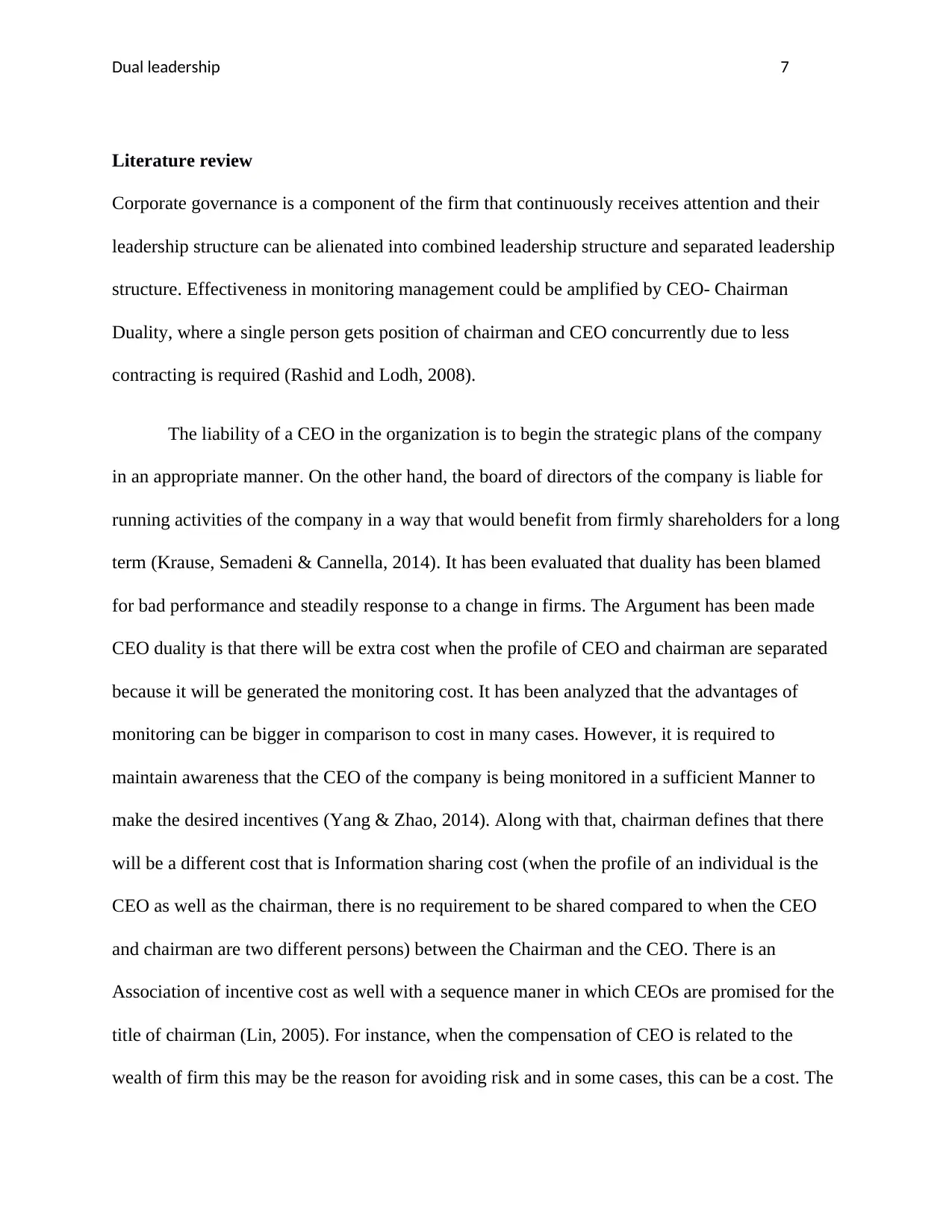
Dual leadership 7
Literature review
Corporate governance is a component of the firm that continuously receives attention and their
leadership structure can be alienated into combined leadership structure and separated leadership
structure. Effectiveness in monitoring management could be amplified by CEO- Chairman
Duality, where a single person gets position of chairman and CEO concurrently due to less
contracting is required (Rashid and Lodh, 2008).
The liability of a CEO in the organization is to begin the strategic plans of the company
in an appropriate manner. On the other hand, the board of directors of the company is liable for
running activities of the company in a way that would benefit from firmly shareholders for a long
term (Krause, Semadeni & Cannella, 2014). It has been evaluated that duality has been blamed
for bad performance and steadily response to a change in firms. The Argument has been made
CEO duality is that there will be extra cost when the profile of CEO and chairman are separated
because it will be generated the monitoring cost. It has been analyzed that the advantages of
monitoring can be bigger in comparison to cost in many cases. However, it is required to
maintain awareness that the CEO of the company is being monitored in a sufficient Manner to
make the desired incentives (Yang & Zhao, 2014). Along with that, chairman defines that there
will be a different cost that is Information sharing cost (when the profile of an individual is the
CEO as well as the chairman, there is no requirement to be shared compared to when the CEO
and chairman are two different persons) between the Chairman and the CEO. There is an
Association of incentive cost as well with a sequence maner in which CEOs are promised for the
title of chairman (Lin, 2005). For instance, when the compensation of CEO is related to the
wealth of firm this may be the reason for avoiding risk and in some cases, this can be a cost. The
Literature review
Corporate governance is a component of the firm that continuously receives attention and their
leadership structure can be alienated into combined leadership structure and separated leadership
structure. Effectiveness in monitoring management could be amplified by CEO- Chairman
Duality, where a single person gets position of chairman and CEO concurrently due to less
contracting is required (Rashid and Lodh, 2008).
The liability of a CEO in the organization is to begin the strategic plans of the company
in an appropriate manner. On the other hand, the board of directors of the company is liable for
running activities of the company in a way that would benefit from firmly shareholders for a long
term (Krause, Semadeni & Cannella, 2014). It has been evaluated that duality has been blamed
for bad performance and steadily response to a change in firms. The Argument has been made
CEO duality is that there will be extra cost when the profile of CEO and chairman are separated
because it will be generated the monitoring cost. It has been analyzed that the advantages of
monitoring can be bigger in comparison to cost in many cases. However, it is required to
maintain awareness that the CEO of the company is being monitored in a sufficient Manner to
make the desired incentives (Yang & Zhao, 2014). Along with that, chairman defines that there
will be a different cost that is Information sharing cost (when the profile of an individual is the
CEO as well as the chairman, there is no requirement to be shared compared to when the CEO
and chairman are two different persons) between the Chairman and the CEO. There is an
Association of incentive cost as well with a sequence maner in which CEOs are promised for the
title of chairman (Lin, 2005). For instance, when the compensation of CEO is related to the
wealth of firm this may be the reason for avoiding risk and in some cases, this can be a cost. The
Paraphrase This Document
Need a fresh take? Get an instant paraphrase of this document with our AI Paraphraser
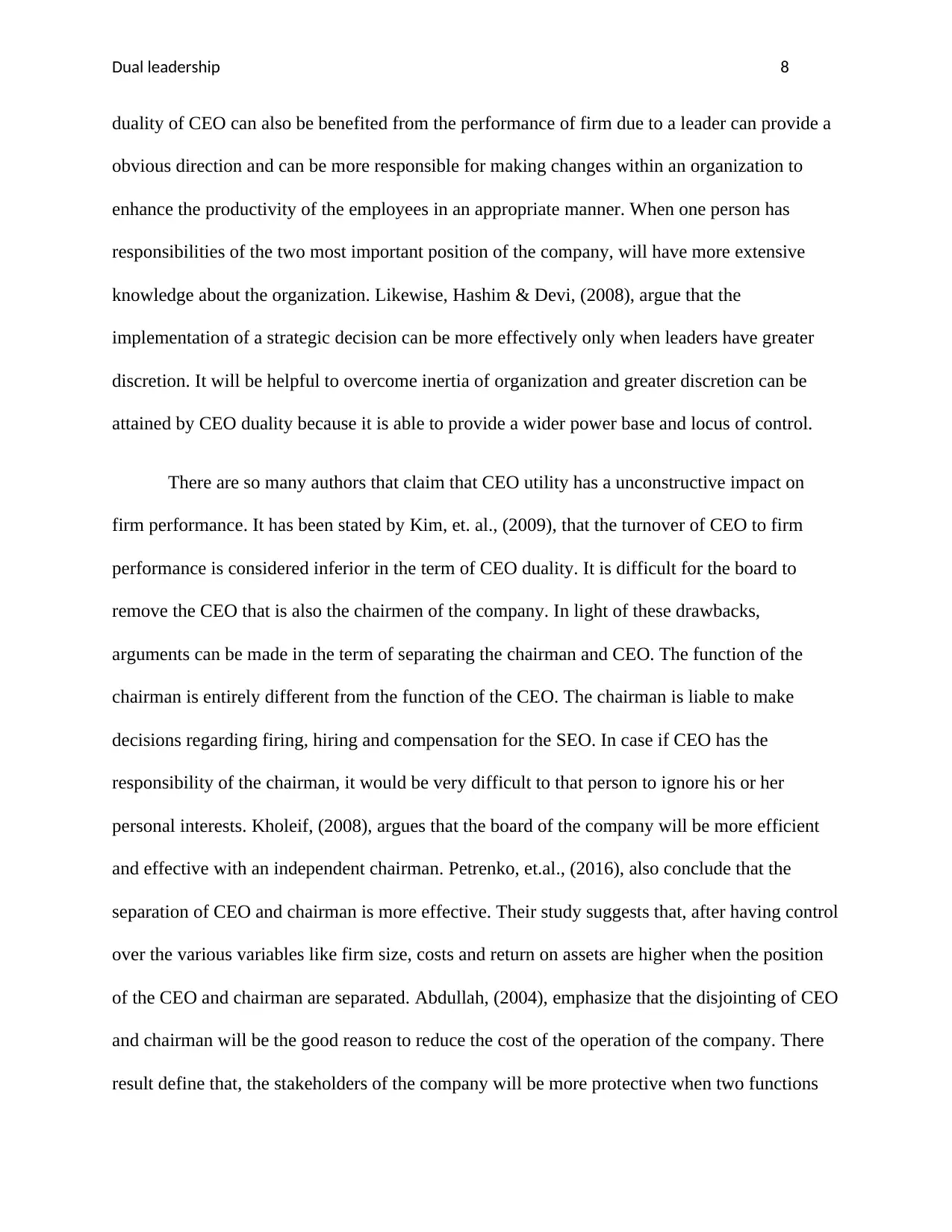
Dual leadership 8
duality of CEO can also be benefited from the performance of firm due to a leader can provide a
obvious direction and can be more responsible for making changes within an organization to
enhance the productivity of the employees in an appropriate manner. When one person has
responsibilities of the two most important position of the company, will have more extensive
knowledge about the organization. Likewise, Hashim & Devi, (2008), argue that the
implementation of a strategic decision can be more effectively only when leaders have greater
discretion. It will be helpful to overcome inertia of organization and greater discretion can be
attained by CEO duality because it is able to provide a wider power base and locus of control.
There are so many authors that claim that CEO utility has a unconstructive impact on
firm performance. It has been stated by Kim, et. al., (2009), that the turnover of CEO to firm
performance is considered inferior in the term of CEO duality. It is difficult for the board to
remove the CEO that is also the chairmen of the company. In light of these drawbacks,
arguments can be made in the term of separating the chairman and CEO. The function of the
chairman is entirely different from the function of the CEO. The chairman is liable to make
decisions regarding firing, hiring and compensation for the SEO. In case if CEO has the
responsibility of the chairman, it would be very difficult to that person to ignore his or her
personal interests. Kholeif, (2008), argues that the board of the company will be more efficient
and effective with an independent chairman. Petrenko, et.al., (2016), also conclude that the
separation of CEO and chairman is more effective. Their study suggests that, after having control
over the various variables like firm size, costs and return on assets are higher when the position
of the CEO and chairman are separated. Abdullah, (2004), emphasize that the disjointing of CEO
and chairman will be the good reason to reduce the cost of the operation of the company. There
result define that, the stakeholders of the company will be more protective when two functions
duality of CEO can also be benefited from the performance of firm due to a leader can provide a
obvious direction and can be more responsible for making changes within an organization to
enhance the productivity of the employees in an appropriate manner. When one person has
responsibilities of the two most important position of the company, will have more extensive
knowledge about the organization. Likewise, Hashim & Devi, (2008), argue that the
implementation of a strategic decision can be more effectively only when leaders have greater
discretion. It will be helpful to overcome inertia of organization and greater discretion can be
attained by CEO duality because it is able to provide a wider power base and locus of control.
There are so many authors that claim that CEO utility has a unconstructive impact on
firm performance. It has been stated by Kim, et. al., (2009), that the turnover of CEO to firm
performance is considered inferior in the term of CEO duality. It is difficult for the board to
remove the CEO that is also the chairmen of the company. In light of these drawbacks,
arguments can be made in the term of separating the chairman and CEO. The function of the
chairman is entirely different from the function of the CEO. The chairman is liable to make
decisions regarding firing, hiring and compensation for the SEO. In case if CEO has the
responsibility of the chairman, it would be very difficult to that person to ignore his or her
personal interests. Kholeif, (2008), argues that the board of the company will be more efficient
and effective with an independent chairman. Petrenko, et.al., (2016), also conclude that the
separation of CEO and chairman is more effective. Their study suggests that, after having control
over the various variables like firm size, costs and return on assets are higher when the position
of the CEO and chairman are separated. Abdullah, (2004), emphasize that the disjointing of CEO
and chairman will be the good reason to reduce the cost of the operation of the company. There
result define that, the stakeholders of the company will be more protective when two functions
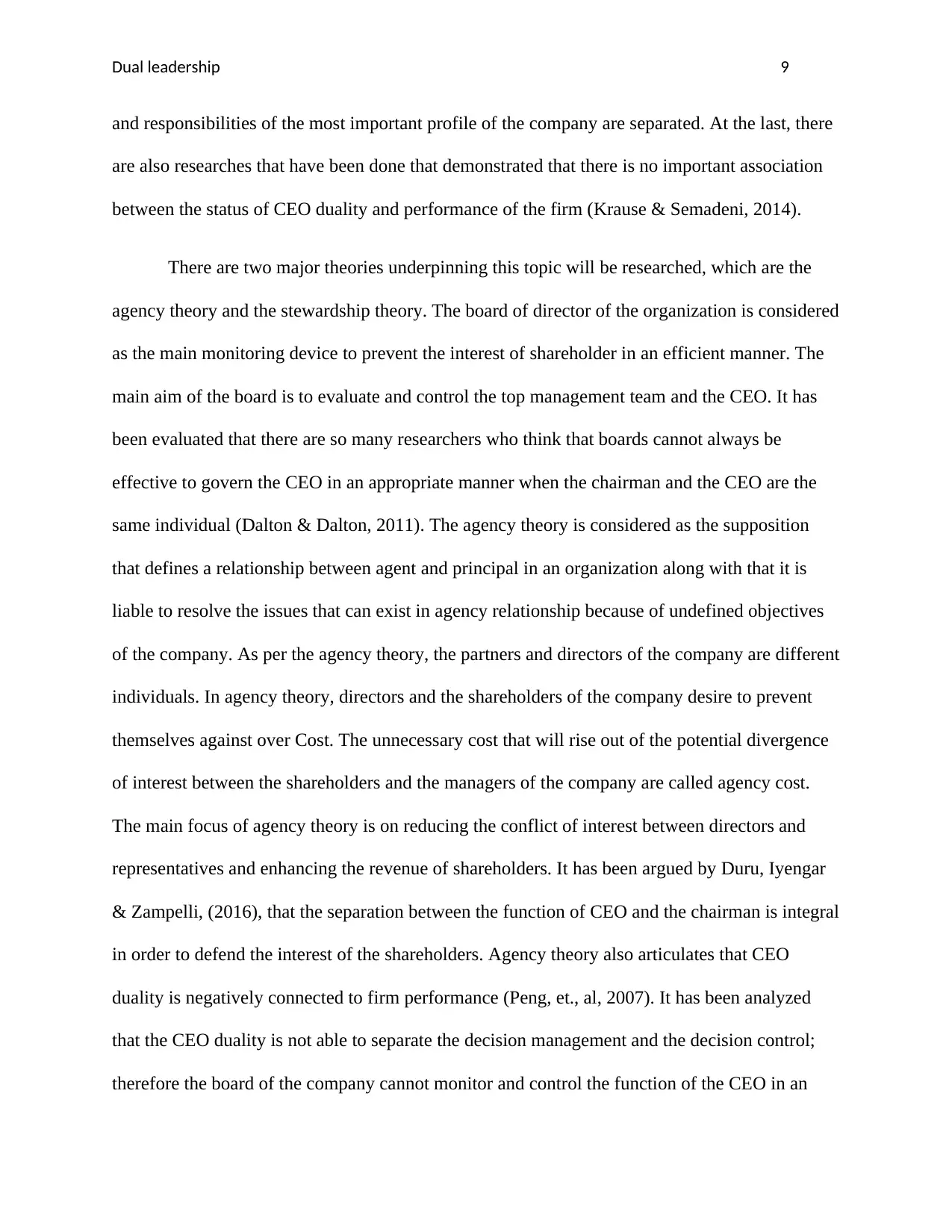
Dual leadership 9
and responsibilities of the most important profile of the company are separated. At the last, there
are also researches that have been done that demonstrated that there is no important association
between the status of CEO duality and performance of the firm (Krause & Semadeni, 2014).
There are two major theories underpinning this topic will be researched, which are the
agency theory and the stewardship theory. The board of director of the organization is considered
as the main monitoring device to prevent the interest of shareholder in an efficient manner. The
main aim of the board is to evaluate and control the top management team and the CEO. It has
been evaluated that there are so many researchers who think that boards cannot always be
effective to govern the CEO in an appropriate manner when the chairman and the CEO are the
same individual (Dalton & Dalton, 2011). The agency theory is considered as the supposition
that defines a relationship between agent and principal in an organization along with that it is
liable to resolve the issues that can exist in agency relationship because of undefined objectives
of the company. As per the agency theory, the partners and directors of the company are different
individuals. In agency theory, directors and the shareholders of the company desire to prevent
themselves against over Cost. The unnecessary cost that will rise out of the potential divergence
of interest between the shareholders and the managers of the company are called agency cost.
The main focus of agency theory is on reducing the conflict of interest between directors and
representatives and enhancing the revenue of shareholders. It has been argued by Duru, Iyengar
& Zampelli, (2016), that the separation between the function of CEO and the chairman is integral
in order to defend the interest of the shareholders. Agency theory also articulates that CEO
duality is negatively connected to firm performance (Peng, et., al, 2007). It has been analyzed
that the CEO duality is not able to separate the decision management and the decision control;
therefore the board of the company cannot monitor and control the function of the CEO in an
and responsibilities of the most important profile of the company are separated. At the last, there
are also researches that have been done that demonstrated that there is no important association
between the status of CEO duality and performance of the firm (Krause & Semadeni, 2014).
There are two major theories underpinning this topic will be researched, which are the
agency theory and the stewardship theory. The board of director of the organization is considered
as the main monitoring device to prevent the interest of shareholder in an efficient manner. The
main aim of the board is to evaluate and control the top management team and the CEO. It has
been evaluated that there are so many researchers who think that boards cannot always be
effective to govern the CEO in an appropriate manner when the chairman and the CEO are the
same individual (Dalton & Dalton, 2011). The agency theory is considered as the supposition
that defines a relationship between agent and principal in an organization along with that it is
liable to resolve the issues that can exist in agency relationship because of undefined objectives
of the company. As per the agency theory, the partners and directors of the company are different
individuals. In agency theory, directors and the shareholders of the company desire to prevent
themselves against over Cost. The unnecessary cost that will rise out of the potential divergence
of interest between the shareholders and the managers of the company are called agency cost.
The main focus of agency theory is on reducing the conflict of interest between directors and
representatives and enhancing the revenue of shareholders. It has been argued by Duru, Iyengar
& Zampelli, (2016), that the separation between the function of CEO and the chairman is integral
in order to defend the interest of the shareholders. Agency theory also articulates that CEO
duality is negatively connected to firm performance (Peng, et., al, 2007). It has been analyzed
that the CEO duality is not able to separate the decision management and the decision control;
therefore the board of the company cannot monitor and control the function of the CEO in an
⊘ This is a preview!⊘
Do you want full access?
Subscribe today to unlock all pages.

Trusted by 1+ million students worldwide
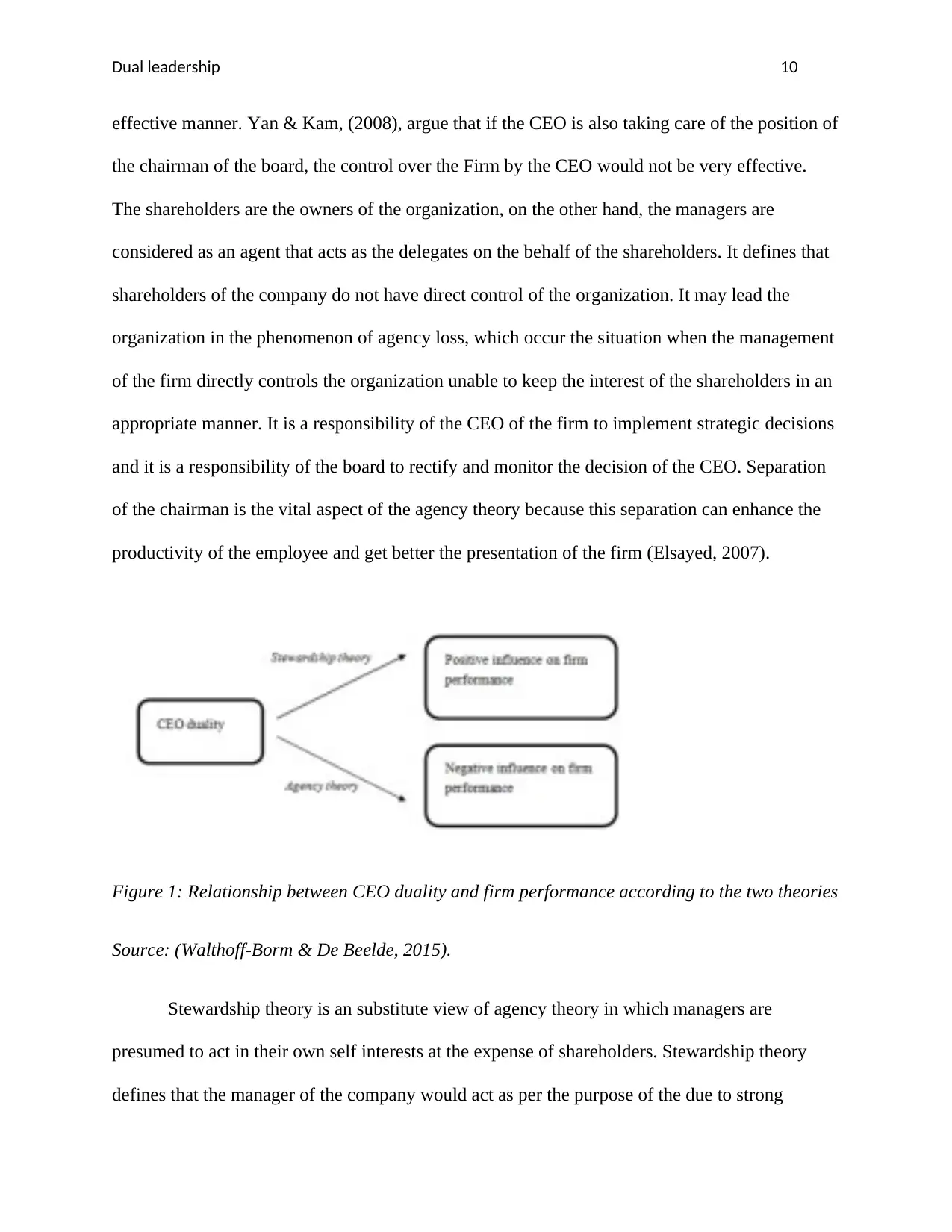
Dual leadership 10
effective manner. Yan & Kam, (2008), argue that if the CEO is also taking care of the position of
the chairman of the board, the control over the Firm by the CEO would not be very effective.
The shareholders are the owners of the organization, on the other hand, the managers are
considered as an agent that acts as the delegates on the behalf of the shareholders. It defines that
shareholders of the company do not have direct control of the organization. It may lead the
organization in the phenomenon of agency loss, which occur the situation when the management
of the firm directly controls the organization unable to keep the interest of the shareholders in an
appropriate manner. It is a responsibility of the CEO of the firm to implement strategic decisions
and it is a responsibility of the board to rectify and monitor the decision of the CEO. Separation
of the chairman is the vital aspect of the agency theory because this separation can enhance the
productivity of the employee and get better the presentation of the firm (Elsayed, 2007).
Figure 1: Relationship between CEO duality and firm performance according to the two theories
Source: (Walthoff-Borm & De Beelde, 2015).
Stewardship theory is an substitute view of agency theory in which managers are
presumed to act in their own self interests at the expense of shareholders. Stewardship theory
defines that the manager of the company would act as per the purpose of the due to strong
effective manner. Yan & Kam, (2008), argue that if the CEO is also taking care of the position of
the chairman of the board, the control over the Firm by the CEO would not be very effective.
The shareholders are the owners of the organization, on the other hand, the managers are
considered as an agent that acts as the delegates on the behalf of the shareholders. It defines that
shareholders of the company do not have direct control of the organization. It may lead the
organization in the phenomenon of agency loss, which occur the situation when the management
of the firm directly controls the organization unable to keep the interest of the shareholders in an
appropriate manner. It is a responsibility of the CEO of the firm to implement strategic decisions
and it is a responsibility of the board to rectify and monitor the decision of the CEO. Separation
of the chairman is the vital aspect of the agency theory because this separation can enhance the
productivity of the employee and get better the presentation of the firm (Elsayed, 2007).
Figure 1: Relationship between CEO duality and firm performance according to the two theories
Source: (Walthoff-Borm & De Beelde, 2015).
Stewardship theory is an substitute view of agency theory in which managers are
presumed to act in their own self interests at the expense of shareholders. Stewardship theory
defines that the manager of the company would act as per the purpose of the due to strong
Paraphrase This Document
Need a fresh take? Get an instant paraphrase of this document with our AI Paraphraser
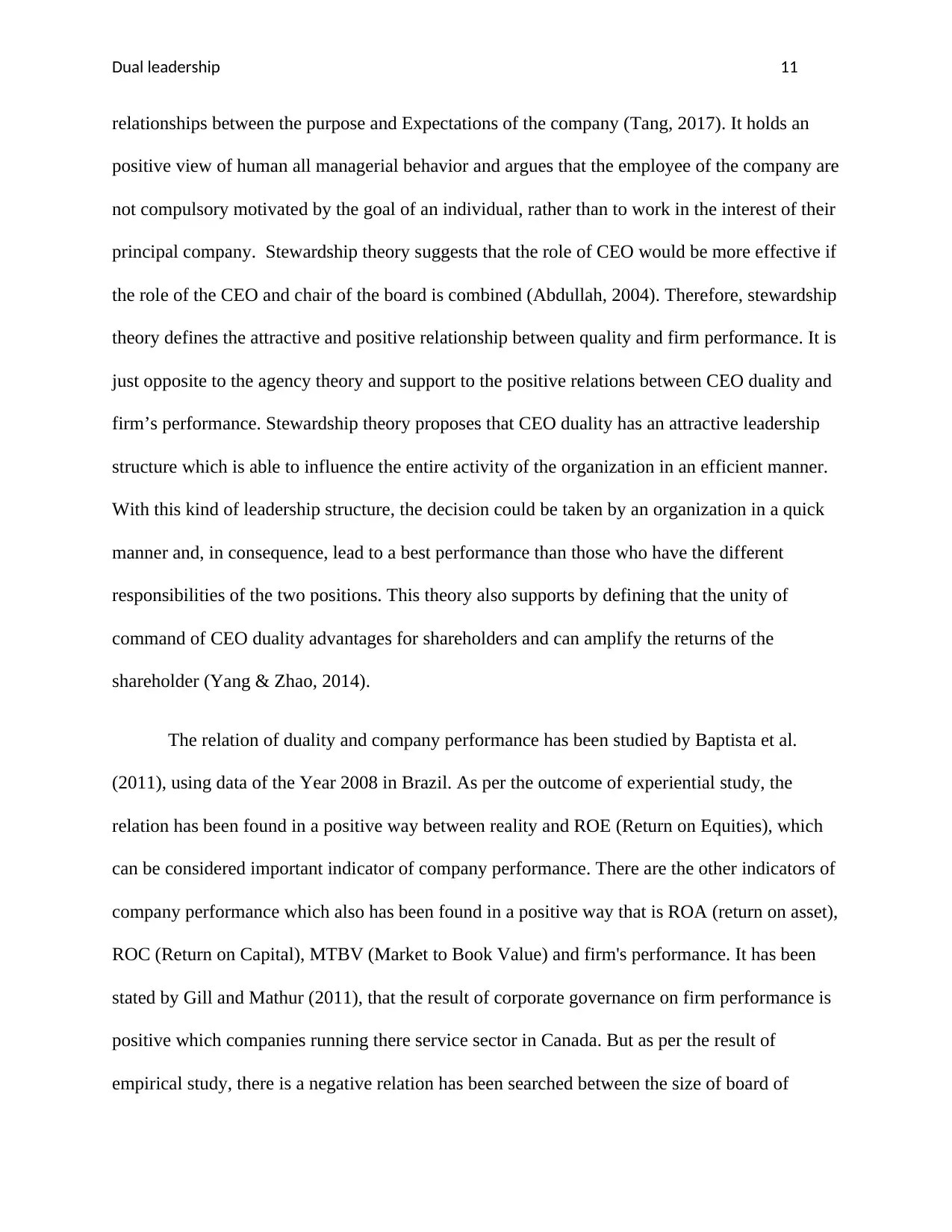
Dual leadership 11
relationships between the purpose and Expectations of the company (Tang, 2017). It holds an
positive view of human all managerial behavior and argues that the employee of the company are
not compulsory motivated by the goal of an individual, rather than to work in the interest of their
principal company. Stewardship theory suggests that the role of CEO would be more effective if
the role of the CEO and chair of the board is combined (Abdullah, 2004). Therefore, stewardship
theory defines the attractive and positive relationship between quality and firm performance. It is
just opposite to the agency theory and support to the positive relations between CEO duality and
firm’s performance. Stewardship theory proposes that CEO duality has an attractive leadership
structure which is able to influence the entire activity of the organization in an efficient manner.
With this kind of leadership structure, the decision could be taken by an organization in a quick
manner and, in consequence, lead to a best performance than those who have the different
responsibilities of the two positions. This theory also supports by defining that the unity of
command of CEO duality advantages for shareholders and can amplify the returns of the
shareholder (Yang & Zhao, 2014).
The relation of duality and company performance has been studied by Baptista et al.
(2011), using data of the Year 2008 in Brazil. As per the outcome of experiential study, the
relation has been found in a positive way between reality and ROE (Return on Equities), which
can be considered important indicator of company performance. There are the other indicators of
company performance which also has been found in a positive way that is ROA (return on asset),
ROC (Return on Capital), MTBV (Market to Book Value) and firm's performance. It has been
stated by Gill and Mathur (2011), that the result of corporate governance on firm performance is
positive which companies running there service sector in Canada. But as per the result of
empirical study, there is a negative relation has been searched between the size of board of
relationships between the purpose and Expectations of the company (Tang, 2017). It holds an
positive view of human all managerial behavior and argues that the employee of the company are
not compulsory motivated by the goal of an individual, rather than to work in the interest of their
principal company. Stewardship theory suggests that the role of CEO would be more effective if
the role of the CEO and chair of the board is combined (Abdullah, 2004). Therefore, stewardship
theory defines the attractive and positive relationship between quality and firm performance. It is
just opposite to the agency theory and support to the positive relations between CEO duality and
firm’s performance. Stewardship theory proposes that CEO duality has an attractive leadership
structure which is able to influence the entire activity of the organization in an efficient manner.
With this kind of leadership structure, the decision could be taken by an organization in a quick
manner and, in consequence, lead to a best performance than those who have the different
responsibilities of the two positions. This theory also supports by defining that the unity of
command of CEO duality advantages for shareholders and can amplify the returns of the
shareholder (Yang & Zhao, 2014).
The relation of duality and company performance has been studied by Baptista et al.
(2011), using data of the Year 2008 in Brazil. As per the outcome of experiential study, the
relation has been found in a positive way between reality and ROE (Return on Equities), which
can be considered important indicator of company performance. There are the other indicators of
company performance which also has been found in a positive way that is ROA (return on asset),
ROC (Return on Capital), MTBV (Market to Book Value) and firm's performance. It has been
stated by Gill and Mathur (2011), that the result of corporate governance on firm performance is
positive which companies running there service sector in Canada. But as per the result of
empirical study, there is a negative relation has been searched between the size of board of
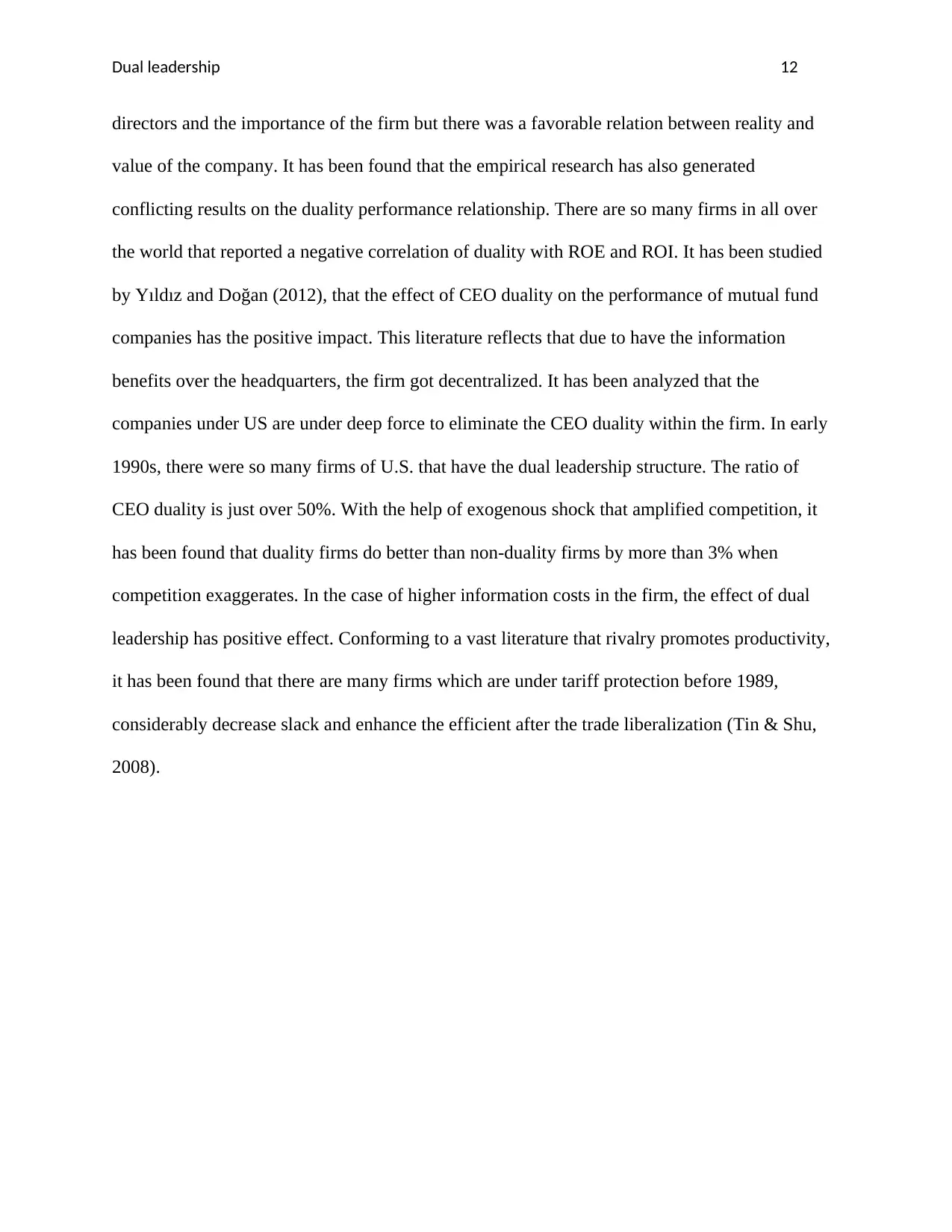
Dual leadership 12
directors and the importance of the firm but there was a favorable relation between reality and
value of the company. It has been found that the empirical research has also generated
conflicting results on the duality performance relationship. There are so many firms in all over
the world that reported a negative correlation of duality with ROE and ROI. It has been studied
by Yıldız and Doğan (2012), that the effect of CEO duality on the performance of mutual fund
companies has the positive impact. This literature reflects that due to have the information
benefits over the headquarters, the firm got decentralized. It has been analyzed that the
companies under US are under deep force to eliminate the CEO duality within the firm. In early
1990s, there were so many firms of U.S. that have the dual leadership structure. The ratio of
CEO duality is just over 50%. With the help of exogenous shock that amplified competition, it
has been found that duality firms do better than non-duality firms by more than 3% when
competition exaggerates. In the case of higher information costs in the firm, the effect of dual
leadership has positive effect. Conforming to a vast literature that rivalry promotes productivity,
it has been found that there are many firms which are under tariff protection before 1989,
considerably decrease slack and enhance the efficient after the trade liberalization (Tin & Shu,
2008).
directors and the importance of the firm but there was a favorable relation between reality and
value of the company. It has been found that the empirical research has also generated
conflicting results on the duality performance relationship. There are so many firms in all over
the world that reported a negative correlation of duality with ROE and ROI. It has been studied
by Yıldız and Doğan (2012), that the effect of CEO duality on the performance of mutual fund
companies has the positive impact. This literature reflects that due to have the information
benefits over the headquarters, the firm got decentralized. It has been analyzed that the
companies under US are under deep force to eliminate the CEO duality within the firm. In early
1990s, there were so many firms of U.S. that have the dual leadership structure. The ratio of
CEO duality is just over 50%. With the help of exogenous shock that amplified competition, it
has been found that duality firms do better than non-duality firms by more than 3% when
competition exaggerates. In the case of higher information costs in the firm, the effect of dual
leadership has positive effect. Conforming to a vast literature that rivalry promotes productivity,
it has been found that there are many firms which are under tariff protection before 1989,
considerably decrease slack and enhance the efficient after the trade liberalization (Tin & Shu,
2008).
⊘ This is a preview!⊘
Do you want full access?
Subscribe today to unlock all pages.

Trusted by 1+ million students worldwide
1 out of 24
Related Documents
Your All-in-One AI-Powered Toolkit for Academic Success.
+13062052269
info@desklib.com
Available 24*7 on WhatsApp / Email
![[object Object]](/_next/static/media/star-bottom.7253800d.svg)
Unlock your academic potential
Copyright © 2020–2025 A2Z Services. All Rights Reserved. Developed and managed by ZUCOL.





